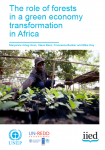On the occasion of the XIV World Forestry Congress, the UN Environment Programme (UNEP) launched a report on 'The Role of Forests in a Green Economy Transformation in Africa.' The report calls for a stronger integration of the largely informal forest sector into national planning and accounting, to boost the sector's productivity while promoting sustainable management of forest resources.
 8 September 2015: On the occasion of the XIV World Forestry Congress, the UN Environment Programme (UNEP) launched a report on ‘The Role of Forests in a Green Economy Transformation in Africa.’ The report calls for a stronger integration of the largely informal forest sector into national planning and accounting, to boost the sector’s productivity while promoting sustainable management of forest resources.
8 September 2015: On the occasion of the XIV World Forestry Congress, the UN Environment Programme (UNEP) launched a report on ‘The Role of Forests in a Green Economy Transformation in Africa.’ The report calls for a stronger integration of the largely informal forest sector into national planning and accounting, to boost the sector’s productivity while promoting sustainable management of forest resources.
Prepared in cooperation with the International Institute for Environment and Development (IIED) and the UN-REDD Programme, the report aims to present policymakers with a strong rationale for linking forests and projects on Reducing Emissions from Deforestation and Forest Degradation in Developing Countries (REDD+) with green economy planning and investments. The authors argue that since Africa’s economies are highly dependent on natural resources, the ability to generate growth in the future and meet wider development priorities will depend on the management of key resources like forests, which is why green economy approaches are increasingly relevant to the continent.
The report first establishes the rationale for linking forests and green economy, showing that forest resources contribute to a green economy in Africa in diverse ways. It then examines the main threats to the forest resource base, starting with the fundamental issue of overlapping rights to forest resources, noting that informal rights associated with traditional systems of governance are rarely given official recognition thereby undermining local users’ incentives to invest in good management. Business-as-usual scenarios to 2030 and 2050 are developed, incorporating likely demand trends for wood and woodfuel based on expected population growth and gross domestic product (GDP). These are matched with estimates of the potential supply of industrial roundwood given the outlook for planted forests and deforestation. These scenarios indicate that demand for industrial roundwood could be two to three times the current levels by 2050. To meet such demand from the existing natural forest designated for production will require harvesting intensities well above sustainable yield, putting severe strain on the forest resource based already threatened by deforestation. Additional pressures from other sectors, agriculture particularly, will have a deleterious effect on the ability of forests to deliver key ecosystem services: carbon emissions will increase and biodiversity will be threatened.
The report draws on examples from Cameroon, Ethiopia, Ghana, Kenya, Mozambique and South Africa to illustrate the pitfalls and advantages of different types of intervention that could contribute to a green economy transformation, and to highlight contextual factors that are important in assessment. This is followed by scenario analysis of the implications of some of these interventions with a focus on two major uses of forest resources: timber and woodfuel. The key message from the scenario analysis is that a package of natural capital and resource efficiency interventions can, in theory, ensure the future of forest resources, while meeting increasing demand. This would be without major compromise to the other contributions of forest resources to ecosystem services that underpin a whole range of growth sectors.
Yet, for these interventions to be scaled up, improvements are needed to the enabling environment. These include: improving forest governance through wider stakeholder participation in forest decision-making processes; encompassing informal users of forest resources; working towards local control and new models of engagement with local people and forest communities; implementing a more nuanced approach to the informal sector that recognizes those actors working legitimately and encourages good practices; promoting access to finance; improving inter-sectoral coordination so that policy measures in sectors that affect or are affected by forests are coherent with those in the forest sector; and improving information on forest assets to document the contribution made by forest ecosystem services to different sectors. [UNEP Press Release] [UN-REDD Press Release on WFC Launch] [Publication: The Role of Forests in a Green Economy Transformation in Africa] [Report Summary] [Natural Resources Policy & Practice Story on the Report Summary]